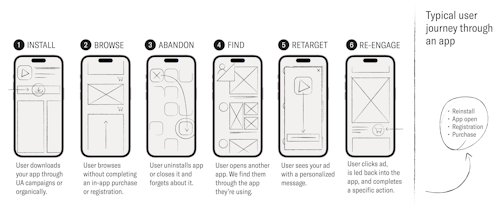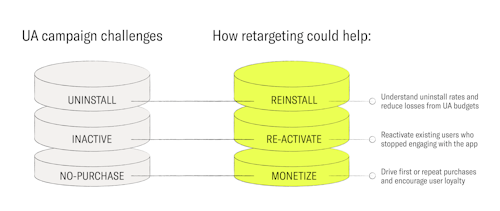A complete guide to programmatic in-app retargeting
November 02, 2023

Written by Remerge, for mobile app businesses and digital advertising agencies.
Contents
- What is in-app retargeting?
- What are the benefits of in-app retargeting?
- How does in-app retargeting work?
- Retargeting in the privacy-first era
- What to consider in a retargeting partner
- Getting started with programmatic retargeting
- Best practices for ad creatives
- Segmentation tips and strategy
- Personalization via dynamic product ads
- Retargeting insights from international experts
- Summary
On this page, you'll find the first few chapters of our guide to in-app retargeting. If you'd like to access all 11 chapters, along with useful resources such as research papers, podcasts and articles, simply submit the form below and we'll email you the full guide for free!
Get the full guide now
1. What is in-app retargeting?
In-app retargeting is a mobile marketing strategy that allows you to locate and target your existing users with relevant ads. These in-app retargeting ads appear within various apps that your customers are using.
By leveraging the data you have collected about your users (which is encapsulated by their unique device ID), you can identify and retarget them with highly personalized ads to strategically address various stages of their user journey in your app.
In section 3 of this guide, we’ll take a deeper dive into the technical aspects of how retargeting works and look at the various players who make up the mobile advertising ecosystem.
Retargeting ads help you:
- Get your newest users to complete an important action within your app, such as a registration or purchase
- Reactivate dormant users and get them to re-engage with your app or make a purchase
- Inform paying users about new app features, or upsell them with offers and promotions


2. What are the benefits of in-app retargeting?
If you are managing an app-based business, in-app retargeting is an essential part of your long-term, sustainable growth strategy. It helps increase your user engagement, retention, and revenue by showing tailored ads to people who have previously downloaded, used, or purchased from your app.
There’s a common misconception that marketers should not retarget newly acquired users until a much later stage in their customer journey. This idea is based on the premise that these users are more likely to convert organically, but the reality is that the vast majority of users who install an app will forget about it, and potentially uninstall it before long. We’ll dive deeper into the stats on this in the upcoming points below.
To improve retention rates, user acquisition campaigns should always be backed up by well-planned retargeting strategies from the first day that a user installs your app. This increases in-app engagement and keeps your audience consistently engaged. The chances of a new user spending money in your app and continuing to use it in the long-run are much higher when they are part of a retargeting campaign. For instance, studies show that retargeted users have an overall 152% higher engagement rate than newly acquired users who are not retargeted.

Here are the main reasons why retargeting is essential for your app’s growth:
1. Retargeting complements your user acquisition (UA) strategy
Every app growth campaign begins with UA. The launch phase of an app focuses on boosting installs, account registrations, and getting new users to enter your app. For UA, marketers want to establish a large user base and optimize their ad spend based on the cost per install. But these are not the only things to focus on when developing your app marketing strategy.
Although obtaining more users is necessary for app growth, app marketers should put plans in place to monitor whether those same users are still engaging with your app after the install. The long-term aim of any app growth strategy is to improve the lifetime value of users – so it’s key to start running your retargeting campaigns before users begin to churn.
One report found that in 2022, 49% of apps were uninstalled within the 30 days after they were downloaded – and almost half of those uninstalls took place within just 24 hours. Speaking on the topic, Ekaterina Li, Principal Account Manager at Remerge explained at the Mobidictum conference in Istanbul: “User acquisition by itself isn’t enough. Many studies show that around 90% of daily active users will churn in the seven days after installing an app, so your investment in UA won’t be worth much unless you build a robust retention strategy from day one.”
2. Retargeting maximizes the value of your existing user base
Mobile apps need a constant flow of new users to grow, but they also need retargeting campaigns to retain and nurture their existing customers. Retargeting campaigns focus on engaging customers who already have your app installed and are familiar with how it works, so it only takes a few steps to complete the actions that your ads ask of them – whether it’s finalizing their account registration within your app, unlocking a new level in a game, making an in-app purchase or completing some other conversion goal.
The first-party data you have on your users can tell you a lot about how they interact with your app. You can use these insights to build sophisticated audience segments, which allow you to create more tailored ad experiences that help you hit your conversion goals.
3. Retargeting establishes brand recall
Retargeting helps to keep your brand at the forefront of your customers’ minds – which is the first step towards retaining them. Retargeting does this by establishing brand recall, where users are familiar with your app and are therefore more likely to interact with it in the future. Continuing to make users aware of your app also increases the chances of conversion when they are ready to take action.
4. Retargeting drives revenue
Studies show that retargeted users generate on average 37% more revenue events in the first 30 days after install compared to users who have only been exposed to UA campaigns. It’s also cheaper to re-engage existing users than to acquire new ones. In fact, acquiring a new user can be five to ten times more expensive than the cost of re-engaging an existing one.
You can also use retargeting ads to support upselling campaigns and show your loyal users the perks and benefits of spending money in your app. This is a chance to draw attention to premium subscriptions, new features, or new products within your app.
A retargeting partner such as Remerge can use your in-app data to segment your high and low-paying users based on their activity, then show them personalized ads with the offers that they are most likely to click on.
5. Retargeting improves other in-app conversion goals
UA becomes harder when your app is established or if you are operating in a saturated market, so it’s worth investing in retargeting to achieve other goals. Users are spending more time and money than ever before on their smartphones — the average person spent 4.8 hours a day on their mobile devices in 2021, which led to a total spend of over $170 billion on the app market that year. Retargeting helps you connect with these users and guide them to the next stage of your sales funnel.
Other conversion goals could include:
- Reminding users to complete a purchase if they have abandoned their shopping cart or food order
- Encouraging users to sign up for a paid subscription after their free trial has ended
- Get mobile gamers to unlock a new character or new game level, generating engagement and loyalty for the game

3. Sign up now to get the full guide for free!
To get the next nine chapters on in-app retargeting, along with useful resources such as research papers, podcasts and articles, submit the form below and we'll email you the full guide for free!





